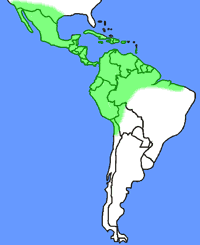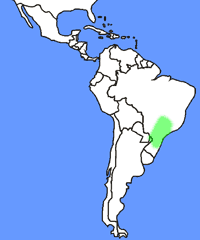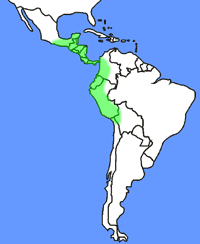Wild capsicums |
Written by Tommi Hietavuo
Photos by Jukka "Fatalii" Kilpinen & Tommi Hietavuo
Genus capsicum |
|
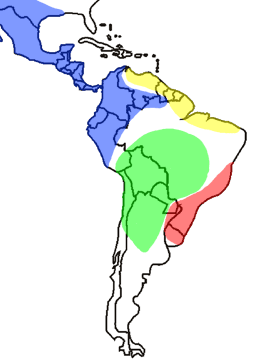 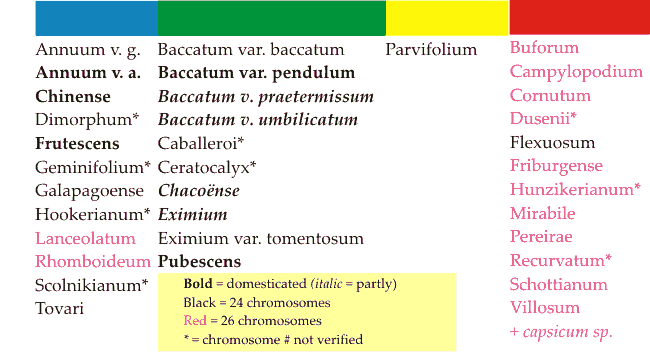 |
|
|
The history of capsicum is still quite poorly known. The latest research from Brazil (Bianchetti et al.) suggests that capsicums with 2n=26 chromosomes represent the original ancient, most primitive chile form. These plants apparently grew in wet lowland forests and didn't try to attract birds but possibly bats with their pendant, non-pungent berries. Originally, the primitive capsicums may have grown in a huge area from south-east Brazil (marked in red) to Chile and up to Central America where two species (c.lanceolatum & c.rhomboideum) still grow rare as kind of living fossiles from the past. When the Andean mountain range was formed, these humid climate rain forest plants had to adapt to completely different conditions of high, dry & open spaces. This adaptation seems to have resulted in pungent, erect berries which attract birds but not mammals. This pungency, the main reason for many chili lovers to grow and enjoy peppers, isn't therefore "native" to chile peppers - it's something that developed much later, to adapt to different growing conditions. For some reason, a pair of chromosomes was lost in the process - and therefore these younger "mountain peppers" which today dominate the world, have a chromosome count of 2n=24. These two evolutionary lines don't cross with each other, according to tests. There are two known bridge species between the Old and New lines: c.flexuosum and c.parvifolium. Both have features from both lines and can be interesting at least for cultivation purposes. Categorizing plants can be very frustrating, and in case of peppers, it is almost a hopeless task. So, please consider the categorization used here only as a tool to have some - even artificial - clarity to the messy relationships of these plants. The following picture's "green", "orange" and "red" groups are pretty logical, since they group together plants genetically close to each other. What they fail to indicate, though, are the inter-relationships between these groups and especially how all the poorly known "other" species relate to them. In case of "yellow", the proposed original primitive peppers of Brazil & Central America, there are subgroups, too - but it would be far too early to try to describe them here. The recent work of Hunziker, Barboza, Bianchetti & others has already revealed several, possibly more than 10 new wild capsicums from Brazil alone. This is probably just the beginning. Accepting 26-chromosome varieties such as formerly very disputed capsicum rhomboideum (ciliatum) finally into capsicum may affect some other former classifications as well. It will also be very interesting to see whether capsicum's closest relatives, Athenea, Aureliana, Darcyanthus, Eriolarynx, Vassobia, Larnax, Dunalia and Tubocapsicum will be affected (re-classified) in any way. For us, pepper enthusiasts, it would be very interesting to know more about these virtually unknown "half-peppers" and their possible uses. Unfortunately, most of these plants are virtually impossible to find outside their natural growing areas. Even there the local people don't necessarily know almost anything about them. The following diagram will, therefore, change in the future. For example, it's likely that there is a relationship between the "green", "orange" and "red" sections of the picture. Those plants are all more or less closely related - the question just is: how? If & when we count the "brown", truly rare, wild species in the picture, things become even more confusing - and interesting! It is almost certain that some, if not all, of "Andean" capsicums are pretty closely related to each other. We simply don't know enough... Right now, the only "real" barrier between the different kinds of peppers seems to be the number of chromosomes they have. What is interesting is that there seems to be capsicum/"pepper" plants useful for the human beings (those sweet and/or pungent) - and those, the really old ones, not useful for us at all. Or: so it seems... Some of the latest research gives us something to think about. The only (reluctantly) accepted capsicum with bright yellow flowers used to be capsicum rhomboideum (capsicum ciliatum). The latest addition to "capsicum", c.caballeroi, shares the same trait. C.rhomboideum belongs to the "Eastern" capsicum group with 26 chromosomes. When it comes to c.caballeroi, we simply don't know much anything yet.
|
|
 |
|
In the diagram above, the coding is similar to the previous chart/table.
ANDEAN CAPSICUMS: 2n=24
These at least 15 wild and 3..5 domesticated peppers mostly grow west of Brazil, many in the Andean mountain area. These plants include all the chile species man has domesticated so far. Typical for most of these plants is erect flower, light coloured seeds and red, pungent berry. They all probably share chromosome count of 2n=24. Their exact relationships are still unclear, partly even unknown, but for clarity's sake, we use here a simple grouping system. Each group consists of closely related species.
A: ANNUUM-COMPLEX
Three wild species mentioned here, C. annuum var. glabriusculum, c.chacoënse and c.galapagoense are all closely related and in some cases even able to cross-breed. Together they fill almost seamlessly the area from southern USA down to central Argentina. These plants represent the "western capsicum branch" at its purest, and are absent in most parts of Brazil. The three domesticated descendants of wild C. annuum, Capsicum annuum var. annuum, Capsicum chinense and Capsicum frutescens form the base from which virtually all the chile peppers and paprikas known today in North America, Europe and Asia have been developed.
The relationship between the before mentioned domesticated trio is still at best unclear. They are genetically almost similar plants, and e.g. Hunziker (2001) has treated them as just variations of one species. Other researchers disagree, though, and the considerable external differences between these plants justify treating them separately here. It has been suggested that Annuum, Chinense and Frutescens all have a common wild form, but a long ago something happened which formed the still quite wild-like Frutescens form. The Chinense form is believed to have developed from Frutescens. This theory isn't without its weaknesses, though, and the only thing we can be sure of is that all these three plants cross quite easily, and can be used to improve each other commercially.

| 1. Capsicum annuum var. glabriusculum (Dunal) "Tepin, Chiltepin" |
|
||
| From South-West USA to Chile and Northern Brazil | |||
| Flower: erect, stellate, small | Corona: white | Spots: no | |
| Calyx: toothless | Berry: round, red, 5-7mm | Heat: average to very hot (4-9) | |
| Sweetness: no, sharp, spicy flavour | Seed: yellow-brown | Plant height: 1-5m (typically 2m) | |
| Leaves: rather small, glabrous | Habit: a sturdy, tall bush | Chromosomes: 24 verified | |
|
This is the grandmother of nearly all commercial hot & sweet peppers we know today. The plant itself is often big, even huge, and lives long (even 30 years). Since this is the ancestor of several domesticated chile species, it's natural that there are several strange variations which represent the development of peppers we today call as Capsicum annuum, Capsicum chinense and Capsicum frutescens. All these three distinctive chile species do cross-breed quite easily, and their earliest, wild forms are genetically very similar. Tepin seems to have developed in several different directions due to its huge (although always scarce in plant numbers) natural growing area. At its Easternmost areas where quite strange Brazilean "eastern peppers" dominate, Tepin grows like a tall, strange little tree with few branches, and its berries have almost no pungency at all. In Mexico, Tepins like to grow in shade, under Mesquite trees. A Tepin is quite suitable for home growing, due to its low need of maintenance, good resistance against pests, and ability to set fruit without any special tricks needed. The downside of Tepin is its size... It's not an ugly plant, but it tends to conquer space and demand attention to the point where at least some housewives might try veto... Tepin does tolerate cool climates relatively well, but due to its typically very late ripening fruits, it may not be ideal for outdoors growing in short season areas. An excellent spice when dried & ground. The small berries of a typical "Tepin" are very hot with a distinctive, harsh flavour - cowboys are said to have eaten these in order to stay awake! The plant is mostly very sturdy and can tolerate almost any kinds of growing conditions with ease. One thing it (as most capsicums) can't handle, though, is too sudden change of temperature below ca. 3-5°C. Otherwise, it can adapt to surprisingly low, even slightly freezing temperatures and in some cases "return from dead" after spending the winter in some kind of suspended state in a garage, etc. A tough one, and a pride of your chile garden. Seeds are available in very best special stores and rather commonly in the chilehead community. |
|||
   |
  |
Above: some typical examples of Tepin. The flower is quite small, as is the berry.
Tepins usually grow like a tower, very tall and narrow, with light green leaves.
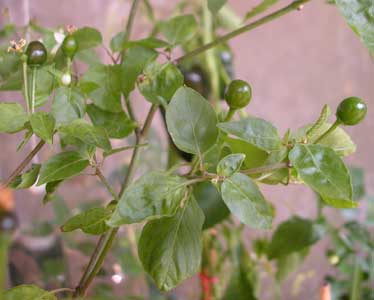
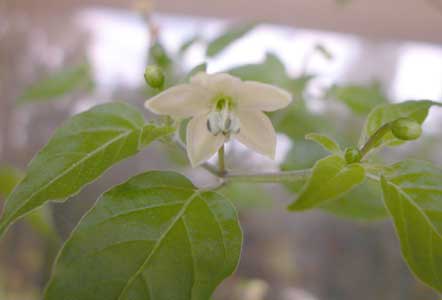
Above: typical Tepin berries and flowers.
1a. Capsicum annuum var. annuum |
Grown virtually all over the Globe, especially on areas where other peppers aren't available.
|
||
| Flower: erect, stellate, often large | Corona: white (rarely violet) | Spots: no | |
| Calyx: toothless | Berry: of any shape and size | Heat: from mild to very hot (0-9) | |
| Sweetness: from missing to very sweet | Seed: yellow-brown | Plant height: 50..120cm indoors | |
| Leaves: smooth, very rarely hairy | Habit: sturdy, tree-like bush | Chromosomes: 24 verified | |
|
Cultivated annuum peppers don't generally look very much like their wild cousins. They tend to be rather small, rarely more than about 120cm tall. They also usually have larger leaves and especially flowers, which can be 20..25 mm in diameter or more. Relatively rare South-American varieties tend to differ from those of Mexican, U.S. or Asian origin. The "Cayenne/Thai" -type hot varieties are often small, bushy plants with small, narrow leaves. Most annuum plants share the appearance and size of "paprika" or "bell pepper". Some ornamental varieties may have purple leaves, flowers and even fruit. The fruits can be of about any appearance, heat and taste. Annuums are generally tricky plants to grow at home or in a garden. They don't usually require such special attention to nutrition, temperature, etc. as e.g. chinenses do. Still, annuums do attract pests like no other pepper - and they also tend to die very easily, especially during the winter time. Seeds are commercially available everywhere. |
|||










From upper left: Jalapeño Hercules flower, Poblano, Ethiopian Brown, Super Chili, Purira, Jalapeño Hercules, Ancient Sweet, Numex Twilight, Bolivian Rainbow, Cayenne
1b. Capsicum chinense |
Growing has concentrated strongly on Caribbean area and, lately, also in Africa where Habanero is exported especially to Europe. Chinense has commercial value in mainland South-America, too, although there its position may be less significant. Rare in Asia.
|
||
| Flower: stellate, small, bell-shaped | Corona: Yellowish-white | Spots: No | |
| Calyx: Almost toothless | Berry: roundish, often wrinkled | Heat: from mild to extreme (0-10+) | |
| Sweetness: mostly present | Seed: yellow-brown | Plant height: 40..100cm indoors | |
| Leaves: large, uneven | Habit: small, usually low tree | Chromosomes: 24 verified | |
|
Chinense peppers are among the easiest to recognize due to their low, tree-like stems, large, uneven leaves, and small, yellowish, somewhat bell-shaped flowers. And of course, if you taste a chinense, chances are that you'll never forget it... These are by far the hottest peppers in the world, although there are some exceptions to the rule. A typical chinense is relatively small, often wider than tall. The South-American varieties can be quite different from the most common Caribbean varieties. They can have purple tint about everywhere, and the plants can grow very tall, up to 2m. Chinenses are coveted home-growing peppers, but they are not the easiest plants to grow. They are not nearly as prone to pests and other problems as domesticated annuums are, and do grow quite easily in all kinds of conditions. The problem with chinenses is that they are very demanding about the nutrition, temperature and other details when setting fruit. |
|||




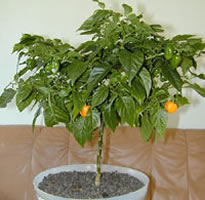

The flower of C. chinense is very characteristic with is yellow/greenish tint, small, pendant, somewhat bell-shaped form and purple anthers.
From upper left:
Goat Pepper flower, Habanero Hawaiian flowers, Habanero Caribbean Red, Habanero Brown Large, Habanero Orange plant, Cajamarca.
1c. Capsicum frutescens (Kuntze) |
Frutescens is mainly grown in Central and South-America, but also in Africa (Piri-Piri) and in Asia.
|
||
| Flower: Erect, small, sharp curve | Corona: Greenish | Spots: No | |
| Calyx: Toothless | Berry: Erect, candle-like, 2-3cm | Heat: medium to hot (4-8) | |
| Sweetness: No | Seed: yellow-brown | Plant height: 100..200cm indoors | |
| Leaves: smooth, shiny | Habit: tree-like, sturdy | Chromosomes: 24 verified | |
|
Frutescens peppers are rather easy to distinguish. The plants are usually tall, tree-like and sturdy, with very flexible branches. The leaves are of medium size and pretty much like annuum leaves, but tend to be darker and shinier. The ultimate difference is the flower. While of the same shape as annuums, the Frutescens flower is almost always smaller, clearly greenish, and has purple anthers (annuum: white). The fruit is almost always a candle-like, 1..5.2cm tall berry with no sweetness and quite high heat. Although C. frutescens is said to be a domesticated pepper, it is closer to wild capsicums than any other domesticated pepper. Frutescens peppers are quite suitable for home-growing, because the plants are rather pretty, pest-resistant, and also very usable for cooking. They are also rather selective to their growing conditions, and don't necessarily set flowers or fruit very easily. Seeds are available about everywhere, but many of the claimed frutescens seeds are annuums. |
|||






See the greenish flower petals and purple anthers, traits no C. annuum var. annuum has. The fruits are almost always of similar colour, size and shape. Rare exceptions like Aji Gusanito (bottom left) are probably crossings, or perhaps represent the earliest forms of C. chinense (which may have developed from frutescens). A typical frutescens plant looks quite different from typical domesticated annuums. The only pretty much similar looking annuums are certain Thai/Cayenne type Asian varieties, but frutescens plants grow much taller than they do, and the flowers can't be confused.


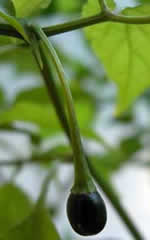
This is quite a unique plant, PI-632932 from Guatemala. The plant is very small ((0.5m) and despite its characteristic Tepin-type flowers, it has many very frutescens-like features. See the way the flower bends and the shiny leaves, for example. The berry isn't round as in annuum-Tepins usually are, but compressed. This may well be a rarely seen wild form of Capsicum frutescens (Kuntze), showing how Tabasco and other domesticated frutescens' may have developed from their common, wild annuum-ancestors. See growing site.
2. Capsicum chacoënse (Hunziker)
|
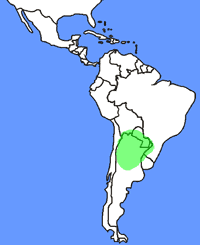 |
||
| Argentina, Bolivia, Brazil, Chile, Paraguay | |||
| Flower: erect, very small | Corona: pure white (very rarely purple) | Spots: no | |
| Calyx: 10 long teeth (5 or even 0) | Berry: orange-red, oblong | Heat: mild to average | |
| Sweetness: no | Seed:yellow-brown | Plant height: 100..150cm indoors | |
| Leaves: small to medium size | Habit: often bushy, sprawling | Chromosomes: 24 verified | |
|
Chacoënse is closely related to C. annuum and can cross-breed with it. The plant is, however, quite different in most aspects. There seems to be quite different forms of chacoënse around. One is a rather large, wildly sprawling bush. Another form is almost tree-like, tall and with much fewer branches. A special case is a variety often called as "capsicum exile" which differs from other chacoënses in many interesting ways (lack of calyx teeth, etc). Chacoënse is normally easy to recognize. Its leaves kind of lack the usual shine of most capsicums, and can be almost heart-shaped. The oblong fruit with 10 very long calyx teeth is unique, too. The flowers are often extremely small for a capsicum and very pretty. The plant mostly grows in low altitudes. The plant is, perhaps, the easiest of wild chilis to grow at home. It is highly resistant to many pests and needs little attention. It does, however, seem to have a tendency to develop mold problems on its leaves. Chacoënse flowers and sets fruit easily in almost any kind of soil. It doesn't need a lot of light or warmth, either. Some varieties are not very pretty - at worst, an adult "chaco" can look like a massive chaos of countless long, thin branches growing everywhere. The usability of its fruit at home is average; the berries aren't generally very hot and their taste isn't remarkable, either. Some people consider them good when dried and ground, though. It appears that chacoënse can be quite cold, even slightly frost resistant when given enough time to adapt. However, it doesn't seem to like sudden below about +3..5°C temperatures at all... Seeds may be available in very best special stores, but the best way to acquire them is through the community. |
|||
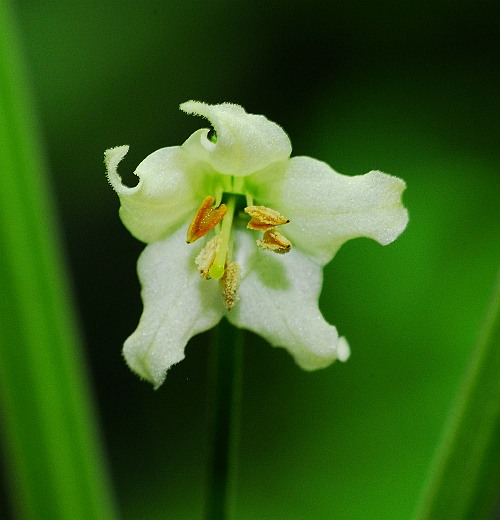






Most chacoënses have very tiny flowers. Their fruits are, however, always bullet- or club-shaped, and relatively large for wild peppers. They fall very easily from the plant.
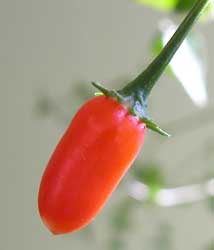
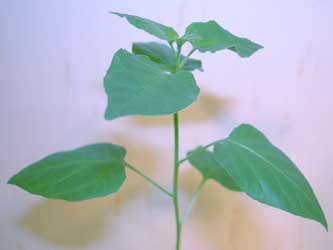
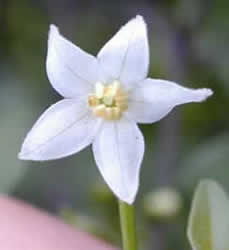
From left: Arivivi (note 10 long calyx teeth!), young Putapario (very typical chacoënse leaves), Exile flower. The plant seems to grow mostly as a tall, a bit tree-like bush with relatively few branches, especially lower in its stem. A notable exception is variety "Exile" which tends to grow into a very thick, messy bush with lots of thin, long branches. As perhaps expected from a semi-domesticatec plant, the variations among chacoënses are numerous, but generally quite small.


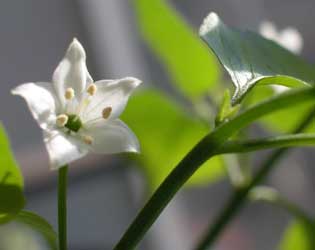
From left: CO5641, a very rare and unique variation of c.chacoënse with dark, purple-tinted leaves and clearly purplish flowers. The plant itself is very small. The next photos are of a Bolivian variety, PI-260435. Note the very long calyx teeth.
Growing sites:
PI-560944 "Putapario" (Argentina)
GRIF-15050 (Paraguay)
GRIF-15051 (Paraguay)
3. Capsicum galapagoense (Hunziker) |
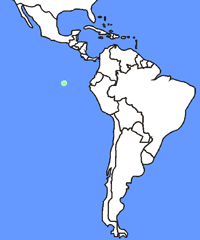 |
||
| Ecuador: Galapagos Islands | |||
| Flower: erect, stellate, small | Corona: white | Spots: no | |
| Calyx: no teeth | Berry: red, slightly compressed | Heat: very hot | |
| Sweetness: no | Seed: yellow-brown | Plant height: 50..120cm indoors | |
| Leaves: pubescent, strongly fragrant | Habit: bushy | Chromosomes: 24 verified | |
|
Notes: as one might expect from anything coming from Galapagos Islands, this capsicum is endemic - and very strange! It is a rather small plant with distinctive, densely hairy leaves which spread strong, pleasant odour when touched. The leaves are small, like the pure white, Tepin-like flower and the berries. The shape of leaves resembles C. annuum plants. It also apparently crosses with annuum to some extent. Galapagoense is one of the most challenging capsicums to grow at home. It clearly demands fundamentally different growing conditions from most other species, and those conditions are still quite unclear (unless, of course, one can recreate the climate etc. of Galapagos...). As result, the plant can grow and even look quite healthy indoors or in a garden, but it doesn't bloom easily - or in some cases, at all. It is also bad at handling cold weather, especially sudden changes of that kind. Seeds are commercially unavailable, but can very rarely be found from the grower community. |
|||






The most striking feature of c.galapagoense is its silvery "fur", clearly visible everywhere. Further amazement follows when someone touches the plant and the strong perfume odour fills the room. For some reason, this fragrance isn't around all the time, and seems to depend on some still uncertain growing conditions. Perhaps the plant only uses the trick in blooming season, in order to attract more pollinators.
B: BACCATUM COMPLEX
This mainland South-American group consists of 3-4 wild and one or two domesticated species (C. baccatum var. pendulum & umbilicatum) growing from Bolivia to south-eastern Brazil. They are all genetically still quite close to the Annuum-complex peppers and, in some rare cases, may cross with them. The possible link with "Eximium complex" peppers remains to be seen. A fact is that some types of C. baccatum var. praetermissum are very similar to certain types of c.eximium.
4. Capsicum baccatum var. baccatum (Eshbaugh) |
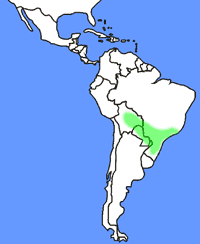 |
||
| Bolivia, Brazil, Paraguay | |||
| Flower: erect, rotate, small | Corona: white | Spots: green (yellow-brown) | |
| Calyx: no or small 5 teeth | Berry: red, round or oblong | Heat: medium hot | |
| Sweetness: no | Seed: yellow-brown | Plant height: 100..150cm indoors | |
| Leaves: smooth, relatively small | Habit: bush | Chromosomes: 24 verified | |
|
The wild grandmother of the mighty "Aji" peppers of South America is a surprisingly humble, relatively small plant. It resembles the domesticated baccatums, especially the small-leaved, bushy, hot "Lemon Drop" -form plants quite a lot. The plant is generally smaller than wild "Tepin" annuums, and unlike the huge "Aji" baccatums, doesn't necessarily need supports. The leaves are typical to baccatums, light green, smooth and sometimes a bit sticky. The flower is a miniature version of domesticated baccatum flowers, and the tiny berry is very similar to wild annuum berries. Many wild and especially semi-wild baccatum berries seem to have a unique, more or less visible feature: on tip of the berry, there is often either a flat area, or a clear depression. The plants tend to grow on hills and plains. Wild baccatums are generally as easy to grow at home as their domesticated cousins are. Their practical or ornamental value may not be that great for most due to often weak prolificiency, small and average-tasting berries, and the size of the plant (while not huge, they're definitely not small ornamentals you just place on your window sill). For those interested in chiles, they do, however, offer a fascinating wild plant to research and, possibly, cross-breed to other plants. Wild baccatums may handle suspended low temperatures rather well when given time to adapt, but they also seem to be among the first ones to die if taken too suddenly below about +5°C temperatures. Seeds may be found from few seed stores, but are more common in the community. |
|||
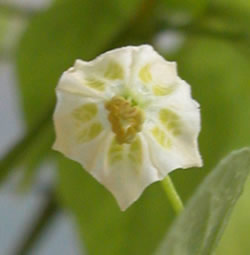
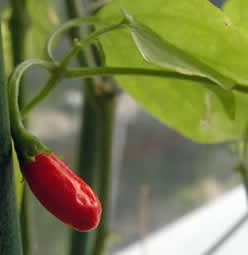

Above: PI-596059 (Bolivia) - see the growing site (satellite photo) + PI-238061 leaves.

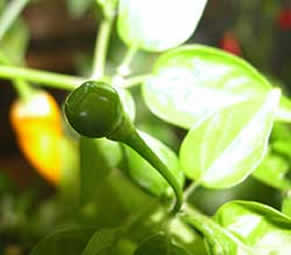
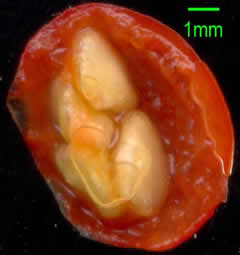
PI-238061 (Bolivia)
4a. Capsicum baccatum var. pendulum |
Domesticated baccatum is grown in most parts of Central and South America as well as in the Caribbean Islands. It is very rare in other continents.
|
||
| Flower: erect, rotate, medium to large | Corona: white | Spots: green or golden | |
| Calyx: toothless | Berry: of almost any shape/colour | Heat: mild to very hot | |
| Sweetness: missing to very sweer | Seed: yellow | Plant height: 50..400cm | |
| Leaves: smooth, light green, large | Habit: bushy or very tall | Chromosomes: 24 verified | |
|
There are at least three major variations of domesticated C. baccatum. The best known of these is probably the classic "Aji"; usually a very tall plant with relatively few huge, sticky leaves and a large, pendant, hot & sweet fruit. The second major variation might be called as "Lemon Drop type" according to one of its most coveted varieties. These baccatum plants are a lot smaller, very bushy, with smaller leaves, and bear smaller, very hot fruit with no sweetness at all. The third major type could be called as "Brazilean baccatum". The plant can be of any size, but often it is very tall for a pepper, tree-like, and has a round or flattened fruit. An example of these would be "Starfish". Many smaller varieties have a flower similar to wild baccatums, with green spots. Larger varieties have a much bigger flower with brown spots. Domesticated baccatums are the easiest capsicums to grow at home. They are seldom very pretty, but don't require much attention, fare rather well against pests, and tend to be quite well-yielding. Small varieties can be early, but bigger ones have a tendency of being late or very late. This is something to consider when growing these plants in short growing season areas. Seeds are available in good stores, quite common among the growing community. |
|||







The flower is mostly rather large with golden brown spots or smaller, with bright green spots. Some fruit forms of domesticated baccatum from upper left:
Criolla Sella flower, Aji Amarillo, Champion, CAP 269, Starfish, Inca Red Drop, Omnicolor.
There are also very small-berried, almost wild forms and other specialities. Baccatum is almost as diverse in form, heat and taste as domesticated annuum.
4b. Capsicum baccatum var. umbilicatum (Vellozo) |
|||
| Flower: - | Corona: white | Spots: yes | |
| Calyx: - | Berry: - | Heat: - | |
| Sweetness: - | Seed: yellow | Plant height: - | |
| Leaves: - | Habit: - | Chromosomes: - | |
|
This rare variety of Capsicum baccatum is still poorly known. It appears to grow in Bolivia-Paraguay-Brazil area both as cultivated and wild. Characteristically very short stigma. More info will follow when available. |
|||
5. Capsicum baccatum var. praetermissum (Heiser & Smith) "Cumari" |
|
||
| Brazil, (Paraguay) | |||
| Flower: erect, rotate | Corona: purple (rarely white) | Spots: green (rarely weak/missing) | |
| Calyx: 5 short teeth | Berry: oblong (sometimes round) | Heat: very hot | |
| Sweetness: no, distinctive flavour | Seed: yellow-brown | Plant height: 120..200cm indoors | |
| Leaves: pubescent or smooth | Habit: sturdy bush | Chromosomes: 24 verified | |
|
Praetermissum is definitely one of the most interesting wild capsicum species, and also a source of much confusion. The plant's appearance varies a lot - enough to confuse it with other species like C. baccatum var. baccatum, C. pubescens and especially c.eximium/cardenasii. Sometimes the leaves are hairy, sometimes silky smooth. Sometimes the flower is purple, sometimes white, sometimes with clear spots, sometimes without them. And so on. The variations seem endless, making it very hard to describe what the plant should actually look like. Most typical praetermissums are distinctive, though, with their hairy leaves and tri-coloured flowers. The wildest forms appear to be among the strangest with round berries, white flowers etc. Sometimes praetermissum looks a lot like certain types of c.eximium/cardenasii, to the point where only the general appearance of the plant can give immediate clues about which one is which. The branches are quite different between the species; praetermissum looks like a "normal" bush, or for example, like a wild annuum bush, while eximium/cardenasii tends to grow longer, thinner, sprawling branches. The difference is difficult to describe, but very apparent when one can compare the plants directly. Praetermissum is a semi-domesticated pepper, and probably also at least one genetical source of some Brazilean domesticated baccatum peppers. Its many variations also probably result from this millennia-long cultivation by man. These are home growing -friendly plants. They grow well in many kinds of conditions and produce lots of hot, spicy berries. These berries are very useful for cooking due to their special kind of aroma. There really is a lot more taste in these berries than in, for example, wild baccatum berries. The plant itself is rather good looking, but - unfortunately for many indoors-growers - often very, very big. It can handle most pests quite well, but dislikes sudden coldness. Seeds may be available in some very best seed stores. Also relatively common among serious pepper growers. |
|||
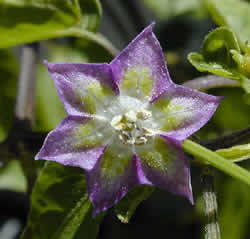


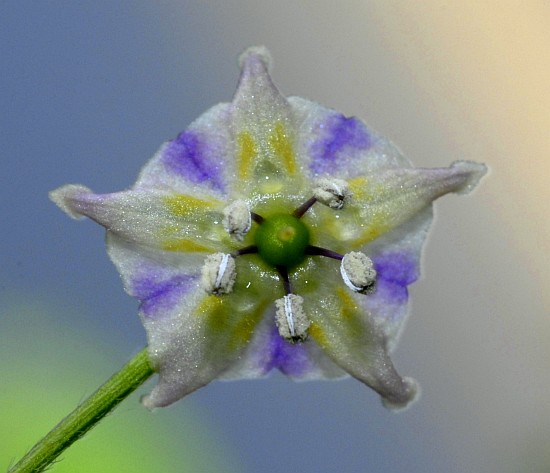


Different flowers from upper left: A "typical" flower, then PI-441654, CGN-22795 (strange, white flower), CAP 1144, Cumari Pollux, CGN 20805.
Note the "divided" spots on petals - a feature not present on capsicum eximium/cardenasii.



Above from left: Cumari Pollux, CGN 22795, CAP 1478.
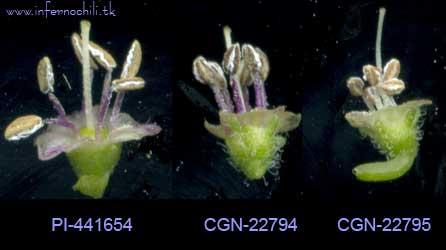
Above: comparison of three different praetermissum flowers. 22795 looks interesting and probably presents the wildest form of this plant. It might also be a cross-form between c.b.praetermissum and some other (whatever that might be) wild capsicum related to it.



General appearance of plants and leaves. On the right, very hairy leaves quite similar to many C. pubescens plants.
6. Capsicum tovari (Eshbaugh et al.) |
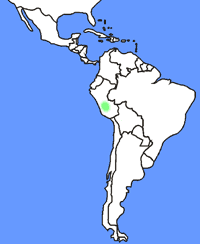 |
||
| Peru | |||
| Flower: erect, rorate, bell-shaped | Corona: yellowish-lilac | Spots: green | |
| Calyx: 5 short teeth | Berry: red, round | Heat: medium hot | |
| Sweetness: no | Seed: yellow-brown, very few | Plant height: 50..100cm indoors | |
| Leaves: smooth, slightly hairy, shiny | Habit: few-branched, sprawling | Chromosomes: 24 verified | |
|
Tovari is one of the rarest capsicums grown by hobbyists. It's also one of the smallest species in capsicum, rarely exceeding 1m height. This small mountain chile from Peruvian Andes doesn't look very much like any other capsicum. Its shiny leaves vary a lot in shape & size. The flower is unique in its mixture of yellow and purple tones, with green spots. Many flowers may grow from one spot. Berries are extraordinarily small, only 3-5mm, translucent green when raw, bright red when ripe. Tovari apparently crosses with both c.eximium and C. baccatum, which again may hint at close relationship between these three species. Growing tovari is easy, although it can be challenging to get any berries. It doesn't require any special conditions and isn't particularly prone to serious pest problems. The plant's practical value for cooking is small, although its tiny berries have the characteristics of a true hot chile pepper. Tovari is, however, a pretty and above all, a very interesting, one-of-a-kind plant that deserves research and protection. Seeds are not available commercially and are also very rare among growers. |
|||



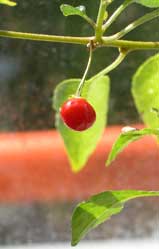
Note the shape and colour of the flower...


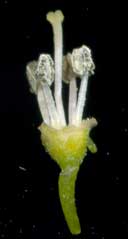
The number of flowers growing from one point is one of tovari's specialities although not entirely unique among capsicums. Click to see PI-606708 from Peru in hi-res.
C: EXIMIUM COMPLEX
This subgroup is surprisingly poorly known, considering that it in addition to 1-3 wild species also includes one domesticated pepper, somewhat mysterious "Rocoto" capsicum pubescens. The wild species are problematic as well, since some researchers call the closest known wild relative to Rocoto as capsicum eximium, some as capsicum cardenasii. And if that isn't confusing enough, some still consider them as different species. This, again, causes headache due to lack of any comprehensible descriptions to tell these species apart... A fact is that whatever we call this plant and its closest relatives, it has the ability to vary a lot in appearance and other traits.
The reason to all this confusion is probably very simple. As very ancient domesticated c.pubescens has at least partly developed from these wild plants, it is very likely that there are countless more or less wild and cultivated variations around, just like in capsicum annuum's case. In this case, there is still an extra element present, creating "interesting times" for researchers. The wild c.eximium/cardenasii crosses quite willingly with domesticated c.pubescens, producing yet again different, half-wild-looking forms (some people call those crossings "Rocopica"). That alone isn't a problem, but it appears that some of these crossings have already eons ago escaped and gone wild again, thus kind of creating a new species. Which, again, has crossed with "true" wild eximiums, Rocotos, etc...
As end result, on a relatively small area in Bolivia, one can find almost anything from small-berried, truly wild c.eximiums to fully domesticated Rocotos - and absolutely everything between those two extremes. With wildly changing naming conventions, it's no wonder that nobody seems to know what to call all these forms of the basically same plant. A.T.Hunziker was among the first to (2001) declare the whole (wild) bunch simply as capsicum eximium. His Brazilean colleagues seem to prefer name capsicum cardenasii, though, so it seems like we'll still have to wait for any agreement on subject. Oh, and it is, indeed, possible that there are several true species inside this poorly known group. At least one, c.eximium var. tomentosum (Hunziker) will almost certainly be counted as a new species in the near future. All clear? Good.
7. Capsicum eximium / cardenasii (Hunziker / Heiser & Smith) "Ulupica" |
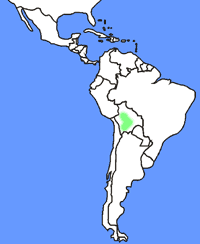 |
||
| Bolivia | |||
| Flower: erect, rotate | Corona: purple | Spots: yellow/green | |
| Calyx: long teeth (5) | Berry: red, round, 5-10mm | Heat: very hot | |
| Sweetness: no | Seed: light to mid-brown | Plant height: 100..200cm indoors | |
| Leaves: smooth, medium size | Habit: sprawling bush | Chromosomes: 24 verified | |
|
The wildest form of this plant is relatively small (1..1.5m) compared to its cultivated cousins. It grows in a distinctive way, forming very long, thin branches. The leaves are also relatively small and don't have clear congruity to those of c.pubescens. The flowers are tri-coloured, sometimes bell-shaped, sometimes not. Purple (rarely almost white) petals have golden spots surrounded by white. Sometimes they look very much like certain c.baccatum var. praetermissum flowers. The spots are, however, not clearly divided in two sections, as praetermissums' tend to be. The typical fruit is a small, round berry with 5 very clear calyx teeth (see photos). When raw it is dark green, when ripe it is bright red and quite hot. These wildest forms of this plant are quite easy to grow even indoors, but like many other wild peppers, they may be difficult to get to produce flowers or especially fruit. Their cold tolerance seems average among peppers. For a pepper enthusiast, these are very fascinating, sometimes even quite pretty plants (when they decide to bloom) with lots of mystery and possible unknown discoveries & opportunities for cultivation etc. For average chili grower, the semi-wild "Rocopica" (see below) form is, however, strongly recommended. |
|||






A typical c.eximium and cardenasii flowers and and some berries. Typical for all wild peppers of this group are long, thin, snake-like branches. The main stem of the plant can also be tough, thin and twisting. The leaves are relatively small, with dullish covering and little or no "hairy" look. The fruits are always round (as opposite to most C. baccatum var. praetermissums) and have 5 long calyx teeth (see the photos). The flowers can be bell-shaped, or flat. Sometimes, the bell-shaped varieties are called as c.cardenasii. Altogether, the differences within this group of closely related plants are rather small, comparable to those within c.chacoënse and less evident than in, for example. c.baccatum var. praetermissum.
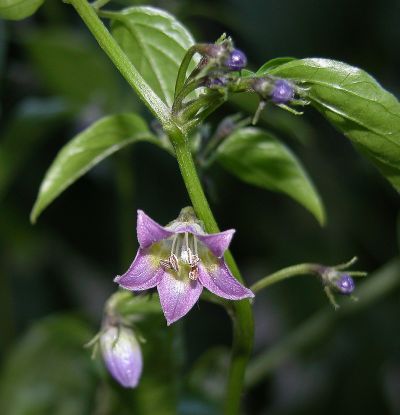
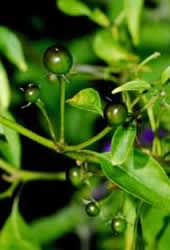
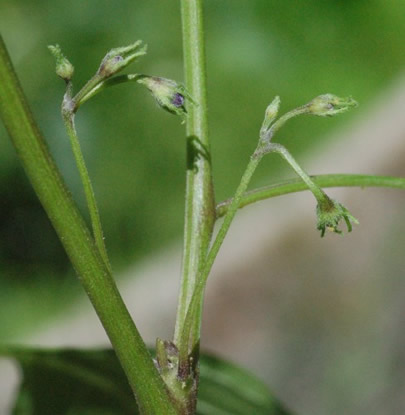







Above: a very strange capsicum, CGN19198. It was at first classified as a c.eximium, then as c.praetermissum. Finally it was classified as a possible crossing of both. The only problem: according to some research, these species shouldn't cross at all... The plant is quite clearly a c.eximium or at least very closely related to it. It's the flowers that make one wonder. This is the first time we here at Inferno have seen divided (see the right photo) flowers in any capsicum. This trait has been observed in several specimens grown from different seeds. The flower also varies a lot in its content of anthocyanin (i.e: amount of purple). What all this means, remains to be seen. Until proven otherwise, Inferno classifies it as a very strange example of c.eximium, but it might even represent a species of its own.
7b. Capsicum cardenasii/eximium var. 'Ulupica, Large' |
|
||
| Bolivia | |||
| Flower: erect, rotate, bell-shaped | Corona: purple | Spots: no | |
| Calyx: long teeth (5) | Berry: red, round, 10mm | Heat: very hot | |
| Sweetness: no, strong spicy flavour | Seed: | Plant height: 150..250cm indoors | |
| Leaves: slightly hairy, smooth | Habit: a rather tall bush | Chromosomes: 24 | |
|
This hybrid form is probably an answer to many questions around wild C. eximiums / cardenasiis and domesticated C. pubescens'. It appears to exist both as an established, truly wild form (in Bolivia), and as an ad hoc crossing between these species. As a plant, it tends to be large - a lot bigger than small-berried, truly wild c.eximiums, and even larger than many c.pubescens plants. The leaves are somewhat pubescent and the general habit of the plant is rather erect, bushy, much less sprawling than that of its wilder cousins. What is very interesting in this variety, is the fact that it doesn't share the "most difficult" traits of both of its parents at all. Unlike both wild c.eximium and domesticated c.pubescens, the "Rocopica" is very easy to grow even indoors, and produces lots of very hot, excellent red berries almost all through the year. The plant itself is a survivor; it can handle pests, hot and cold conditions, drought and about everything with style. It is, although a big plant, also quite pretty. Definitely one of Inferno's all-time favourites for all purposes, including cooking. A serious challenger for all the "common" Cayenne, Thai, Piri-Piri, etc. red peppers with better taste and truly considerable heat! |
|||
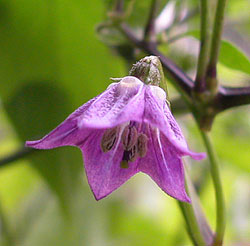
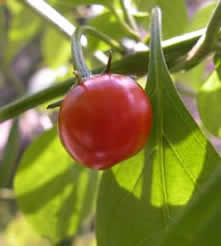


The flower of "Rocopica" is mostly bell-shaped, unlike those of c.pubescens. The fruit is typically at least twice the size of "normal" c.eximiums. The average diameter is ca. 10mm. They have thick flesh and either black or mid-brown seeds. Some research claims that 1st generation "ad hoc" crossings between a c.eximium and a c.pubescens always produce black seeds. As many plants, including my own two specimens, have brown seeds, they may be results from more or less stabilized, even wild forms.
7a. Capsicum pubescens "Rocoto, Chile Manzana, Canario" |
|
||
| Flower: rotate, flat or bell-shaped | Corona: purple | Spots: no | |
| Calyx: long teeth (5) | Berry: large, oval, red, orange or yellow | Heat: from mild to extreme (3-9) | |
| Sweetness: none to quite evident | Seed: black | Plant height: 100..300cm indoors | |
| Leaves: mostly pubescent, rather dark green | Habit: bushy or very tall, sprawling | Chromosomes: 24 verified | |
|
This is probably the oldest of known domesticated peppers, and among the oldest cultivated plants overall. This at least 8000 years old pepper is, curiously, also the least known today among the domesticated species. It has never spread very far outside its native Andean regions, although there are some varieties growing as far North as in Mexico. The plant 's origin is still partly a mystery. It is known to have a close relationship with Bolivia's wild capsicum eximium (cardenasii), but some researchers still think that the wild original form of "Rocoto" has gone extinct. Pubescens grows on high altitudes, typically at 2000...4000m. A typical rocoto is a large, sometimes even huge plant with dark, hairy leaves. It doesn't look like almost any other capsicum (c.galapagoense is close, although a lot smaller). It tends to grow as a tall, wide bush when grown in good conditions (like in a greenhouse). It can also grow very tall and sprawling, especially in indoors, when there is not enough light. The fruits are red (most common), orange or yellow. The red forms tend to have clear sweetness whereas many yellow forms are just scorchingly hot. The aroma and taste of these peppers is, especially in their red forms, relatively close to that of paprika. The fruit is typically of a size of a chicken's egg. The fruit meat is thick and juicy, and therefore especially some yellow forms taste hotter than they actually are. The mixture of different capsaicines in Rocotos is somewhat different from the other domesticated peppers, and therefore, a particularly hot example of a "Canario" (yellow c.pubescens) may surprise even the most experienced chileheads... These peppers are truly delicious - but they can also be very, very hot! Rocotos are considered to be among the most demanding peppers for home growing. The growing itself isn't a problem. These are very humble, pest-resistant, sturdy plants. The problem is in getting these plants to flower and bear fruit. For that, the conditions have to be exactly right. Rocotos dislike hot conditions, and also too strong, direct sunlight. Yet, they need both light and warmth. They appear to like rather steady conditions where there is enough of light and a temperature of around +25 C all the time. These plants can be quite late too, so it's a good idea to take them indoors before the first frosts. Some Rocotos seem to be non-self-compatible, which is rather rare among capsicums. They may therefore need another plant to set any fruit. These plants can live very long, and although somewhat tricky to grow, they are the favourites of very many chile enthusiasts. |
|||






Above:
Pubescens flowers have no spots. The fruits are almost always small round or oval "tomatoes". The plant itself is distinctive and often quite a handsome sight. Often also very, very large... The red example is Red Peruvian Rocoto. The yellow one is a typical "Canario" form of C. pubescens. The more elongated one on the bottom left is a more unique "Locato" which has much smaller pods than rocotos usually have.
Rocoto brown is also very unique because of it's brown color. On the bottom right: a typical growing behaviour of a rocoto plant.
D: OTHER "ANDEAN" CAPSICUMS
These plants are a mixed group with often very poorly known relationships and characteristics. Some of the species may also be extinct by now. Four of the species have mainly been found in Peruvian western coast & mountains. Two other species are different and remarkable since they seem to represent the rare bridge species between the ancient "eastern" capsicum branch and their much better known, newer "western" cousins. Capsicum flexuosum and capsicum parvifolium might therefore be useful for many kinds of research. All these plants are very or extremely rare, and almost impossible to find among the chili grower community. Although there isn't any scientific proof yet, all these plants very likely have 24chromosomes, and thus belong into the "younger" branch of capsicums.
8. Capsicum caballeroi (Nee) |
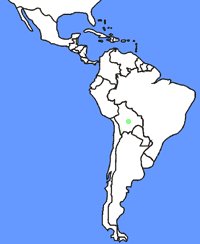 |
||
| Bolivia | |||
| Flower: nodding | Corona: Creamy or bright yellow | Spots: No | |
| Calyx: - | Berry: red (green) | Heat: - | |
| Sweetness: - | Seed: - | Plant height: at least 250cm in nature | |
| Leaves: Long, narrow | Habit: Shrub with single stem | Chromosomes: - | |
|
Grows in Santa Cruz, at least in Amboro National Park, in cloud forests of ca. 2000..3000 m altitude. Recently found & verified. A very unique capsicum with long, sharp leaves apparently somewhat like c.lanceolatum's and bright lemon yellow flowers (like c.rhomboideum but no other capsicums). See dried samples here and here. Growing site 1 Growing site 2 Growing site 3 Seeds are not available. |
|||
9. Capsicum ceratocalyx (Nee) |
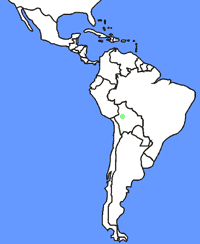 |
||
| Bolivia | |||
| Flower: - | Corona: - | Spots: - | |
| Calyx: - | Berry: - | Heat: - | |
| Sweetness: - | Seed: - | Plant height: - | |
| Leaves: - | Habit: - | Chromosomes: - | |
|
Recently found & verified. Seeds are not available. |
|||
10. Capsicum dimorphum (Miers) |
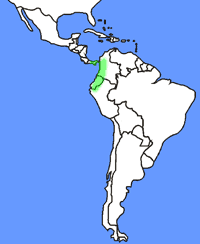 |
||
| Colombia, Ecuador, (Panama) | |||
| Flower: - | Corona: - | Spots: - | |
| Calyx: no teeth, wavy | Berry: - | Heat: - | |
| Sweetness: - | Seed: - | Plant height: - | |
| Leaves: - | Habit: - | Chromosomes: - | |
|
Apparently, also known as brachistus dimorphus. Grows high on the mountains at 1800..3000m. Seeds are not available. |
|||
11. Capsicum geminifolium (Hunziker) |
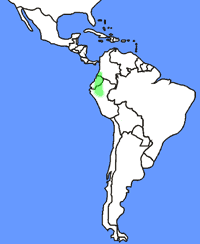 |
||
| Colombia, Ecuador, Peru | |||
| Flower: - | Corona: - | Spots: - | |
| Calyx: - | Berry: - | Heat: - | |
| Sweetness: - | Seed: - | Plant height: - | |
| Leaves: - | Habit: - | Chromosomes: - | |
|
A mountain plant, apparently grows at over 2000m. Grows as endemic plant at least in Piura (Bosque Monteseco), Peru. Threatened. Seeds are not available. |
|||
12. Capsicum hookerianum (Miers) |
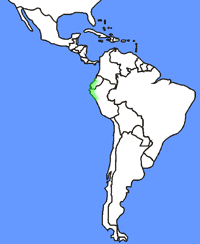 |
||
| Ecuador, Peru | |||
| Flower: - | Corona: yellowish | Spots: no | |
| Calyx: 5+5 teeth, long/short ones | Berry: - | Heat: - | |
| Sweetness: - | Seed: - | Plant height: - | |
| Leaves: - | Habit: - | Chromosomes: - | |
|
Appears to grow in low altitudes, close to the coast. The form of the calyx is unique in capsicums. There are no giant cells within the fruit. Seeds are not available. |
|||
13. Capsicum scolnikianum (Hunziker) |
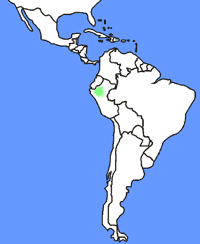 |
||
| Peru | |||
| Flower: bell-shaped, erect | Corona: yellowish | Spots: no | |
| Calyx: - | Berry: - | Heat: - | |
| Sweetness: - | Seed: yellow-brown | Plant height: - | |
| Leaves: elliptical | Habit: - | Chromosomes: - | |
|
Grows at least in Piura, Peru (Bosque Monteseco). Very threatened, endemic plant. There are no giant cells within the fruit. Seeds are not available. |
|||
14. Capsicum flexuosum (Hunziker) |
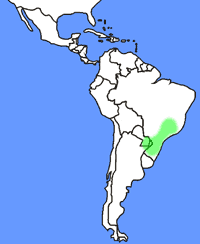 |
||
| Brazil, Paraguay | |||
| Flower: pendant | Corona: white | Spots: green or yellow-brown | |
| Calyx: no teeth | Berry: red (green), depressed | Heat: no to mild | |
| Sweetness: very sweet (!) | Seed: brown/black | Plant height: 1-3m | |
| Leaves: shiny, rigid, waxy | Habit: a compact bush | Chromosomes: 24 verified | |
|
One of the strangest and most fascinating capsicums. This rare bridge-species between the Western and the Eastern capsicums has 24 chromosomes like almost all the Western species do. Still, it does have clear features of the ancient Eastern 26-chromosome group, such as almost non-pungent, pendant fruit and dark seeds.The plant is unlike any more common capsicum with its shiny, kind of wax-coated, narrow, dark leaves. It is not a very large plant, at least indoors (100..150cm). The rather small flower is very much like some wild baccatums and especially the Eastern capsicum varieties with its green or golden spots. The berry is tiny, 3..5mm and matures to orange-red. It has little or some pungency and it is, characteristically, extremely sweet. This is very rare, perhaps even unique trait among wild capsicums. The plant is very easy to grow in all kinds of conditions, but also, unfortunately, reluctant to set any fruit. It's a beautiful plant, especially while blooming (which occurs almost anytime). It is also highly resistant to most pests. The most surprising and, perhaps, very valuable, feature of c.flexuosum is its extreme frost resistance. Two plants of different origin easily survived suspended conditions of -at least 10..-15C (if not even less) in 2005. This trait definitely needs more research, but it's already safe to say that c.flexuosum can tolerate temperatures far below any other known peppers. This could have interesting consequences.... Seeds are not available commercially, but might be obtained through the grower community with some luck. |
|||








Note the clearly reddish, thick, tree-like stem. Flexuosum is a very sturdy plant. The flowers look somewhat like some baccatums, but are clearly smaller and generally more bell-shaped. The spots can be either green or golden brown.
15. Capsicum parvifolium (Sendtner) |
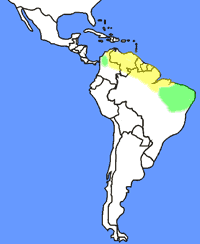 |
||
| From Venezuela to Northern Brazil | |||
| Flower: °90 twisted, stellar, pendant | Corona: white/purple | Spots: green/purple | |
| Calyx: 5 teeth | Berry: red (green) | Heat: scarce | |
| Sweetness: - | Seed: yellow-brown | Plant height: >4m | |
| Leaves: - | Habit: Tree | Chromosomes: 24 verified | |
|
The only known capsicum which grows like a small tree. Seems to like low altitudes. Like C. flexuosum, a bridge species between the western and the eastern capsicums (has traits from both groups). Appears to grow in two separated areas. Seeds are not available. |
|||
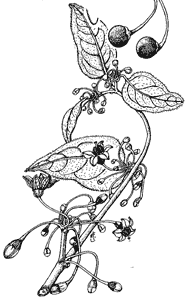
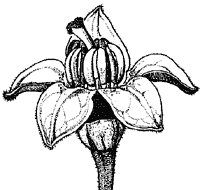 (c) N.Flury/A.T.Hunziker 2001
(c) N.Flury/A.T.Hunziker 2001
ORIGINAL CAPSICUMS: 2n=26
These 13 (in the future, very likely more) wild species of capsicum mostly grow in South-East Brazil's Mata Atlántica zone. All or most of the species may have 26 chromosomes. None of them have been domesticated. Typical for these plants are: pendant flower, dark seeds and yellow-green, relatively (or entirely) non-pungent berry.
16. Capsicum buforum (Hunziker) |
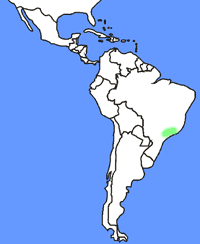 |
||
| Brazil (São Paulo & Rio de Janeiro) | |||
| Flower: - | Corona: - | Spots: - | |
| Calyx: - | Berry: - | Heat: - | |
| Sweetness: - | Seed: - | Plant height: - | |
| Leaves: - | Habit: - | Chromosomes: 26 verified | |
|
This capsicum has been used in several comparative chile research projects in Brazil, but very little is publicly known about it. It appears to be a pretty typical "Eastern Capsicum" with probably alltheir normal characteristics like green berry and dark seeds. May not be self-compatible. Seeds are not available. |
|||






17. Capsicum campylopodium (Sendtner) |
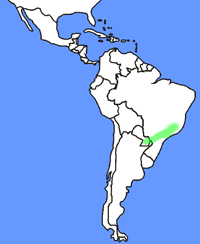 |
||
| Paraguay, Brazil (Espirito Santo, Minas Gerais, Rio de Janeiro) | |||
| Flower: °90 twisted | Corona: white | Spots: yellow | |
| Calyx: no teeth, 5-cornered | Berry: yellow/green (green), oval | Heat: - | |
| Sweetness: - | Seed: - | Plant height: 1-2m | |
| Leaves: - | Habit: - | Chromosomes: 26 verified | |
|
The unique feature of this plant is its 2 long and 3 short filaments. There seems to be at least two variations of the plant. Seeds are not available. |
|||
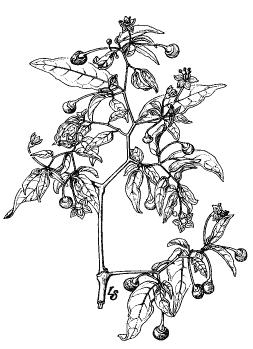
 (c) L.Sánchez/A.T.Hunziker 2001
(c) L.Sánchez/A.T.Hunziker 2001
18. Capsicum cornutum (Hunziker) |
 |
||
| Brazil (Rio de Janeiro, São Paulo) | |||
| Flower: °90 twisted | Corona: white | Spots: green/purple | |
| Calyx: 5-10 teeth | Berry: yellow | Heat: - | |
| Sweetness: - | Seed: - | Plant height: 1-2.5m | |
| Leaves: broad, pubescent | Habit: | Chromosomes: 26 verified | |
|
One of only three capsicum species with varying number of calyx teeth. Seeds are not available. |
|||
19. Capsicum dusenii (Bitter) |
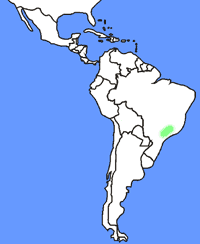 |
||
| Brazil (Rio de Janeiro, São Paulo) | |||
| Flower: - | Corona: white | Spots: orange | |
| Calyx: - | Berry: yellow/green (green) | Heat: present (weak) | |
| Sweetness: - | Seed: - | Plant height: 1-3m | |
| Leaves: - | Habit: a thick bush | Chromosomes: - | |
|
Seeds are not available. |
|||
20. Capsicum friburgense (Bianchetti & Barboza) |
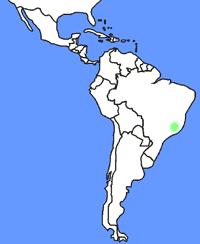 |
||
| Brazil (Rio de Janeiro) | |||
| Flower: pendant, bell-shaped | Corona: purple | Spots: no | |
| Calyx: teeth 5x3mm | Berry: yellow/green (green) | Heat: present (weak) | |
| Sweetness: - | Seed: black/brown | Plant height: 0.8-2 (3)m | |
| Leaves: smooth, narrowly elliptical | Habit: highlands | Chromosomes: 26 verified | |
|
Lives around the Nova Friburgo forest in the altitude of 1700..2000m. One of the few wild capsicums without corolla spots. Also, its pure lilac corolla is a rather unique feature. Related to c.mirabile. |
|||
 (c) Barboza & Bianchetti
(c) Barboza & Bianchetti
21. Capsicum hunzikerianum (Barboza & Bianchetti) |
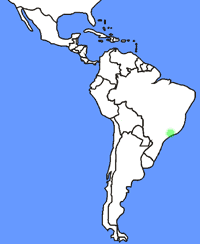 |
||
| Brazil (São Paulo) | |||
| Flower: pendant, stellar | Corona: white | Spots: green/purple | |
| Calyx: 5-20x4mm | Berry: yellow/green (green) | Heat: present (weak) | |
| Sweetness: - | Seed: black/brown | Plant height: 1-3m | |
| Leaves: very tall, narrow, smooth | Habit: marshes etc. | Chromosomes: - | |
|
A newly-found, distinctive species with largest known capsicum flowers and very tall leaves. It is the only so far known capsicum only growing in Eastern Brazilean marshes. The number of calyx teeth varies from 5 to 10. The plant is believed to be closely related to c.cornutum. The variety was named after recently deceased Argentinean capsicum researcher, A.T.Hunziker. |
|||
 (c) Barboza & Bianchetti
(c) Barboza & Bianchetti
22. Capsicum lanceolatum (Greenm.) |
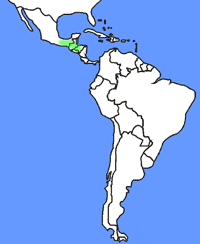 |
||
| Guatemala, Honduras, Mexico | |||
| Flower: °90 twisted, rotate | Corona: white | Spots: green/purple | |
| Calyx: long teeth, 5x5mm | Berry: - | Heat: no | |
| Sweetness: no | Seed: black | Plant height: <150cm (?) | |
| Leaves: narrow, shiny | Habit: sprawling, bushy | Chromosomes: 26 verified | |
|
Lanceolatum and c.rhomboideum are believed to be remnants of the very ancient, original chili plants of South America. After land rose in Western parts of the South American continent, these plants remained isolated in Central America, while their other cousins either changed and became our more familiar "Andean capsicums" or found isolated places to grow in at South-East coast of Brazil. This plant is, apparently, close to extinction, and was only recently re-found by Dr. Bosland et al. (with seeds saved). It appears to compete of the same habitats as people of Central American mountains. This seems to be a problem for many wild capsicums. Lanceolatum is a relatively compact, bushy plant with pretty tri-coloured flowers. The calyx teeth are extraordinarily tall. The fruit ripens from green to bright red and has neither heat, sweetness nor any particular flavour. A tricky plant to germinate and grow at home, it appears. According to Jukka Kilpinen, grows very well in water farming conditions, though. Seeds are not available through normal routes, but some chili growers have them, and it seems like they're also sold somewhere. |
|||







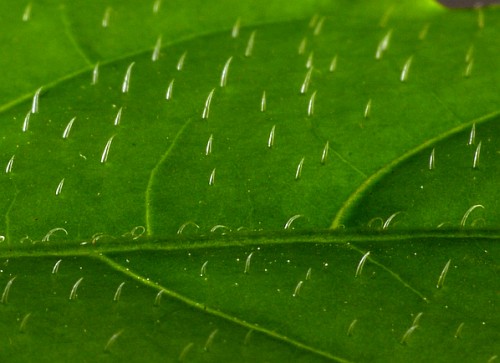

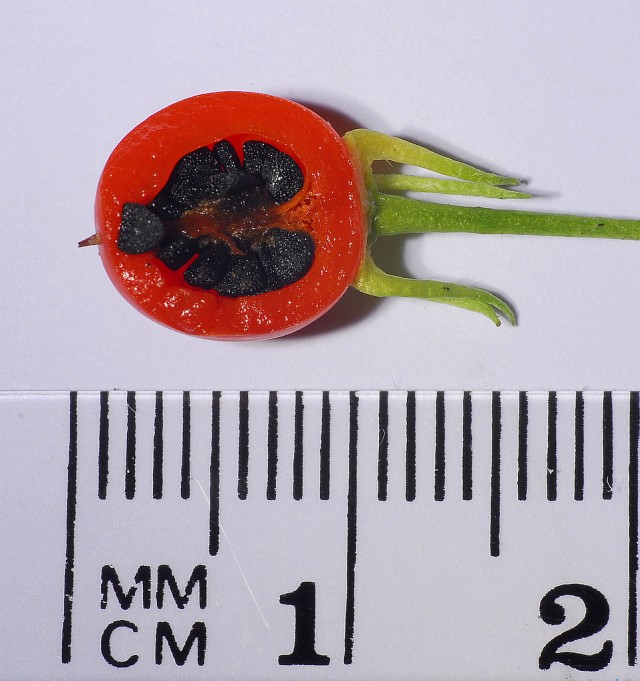
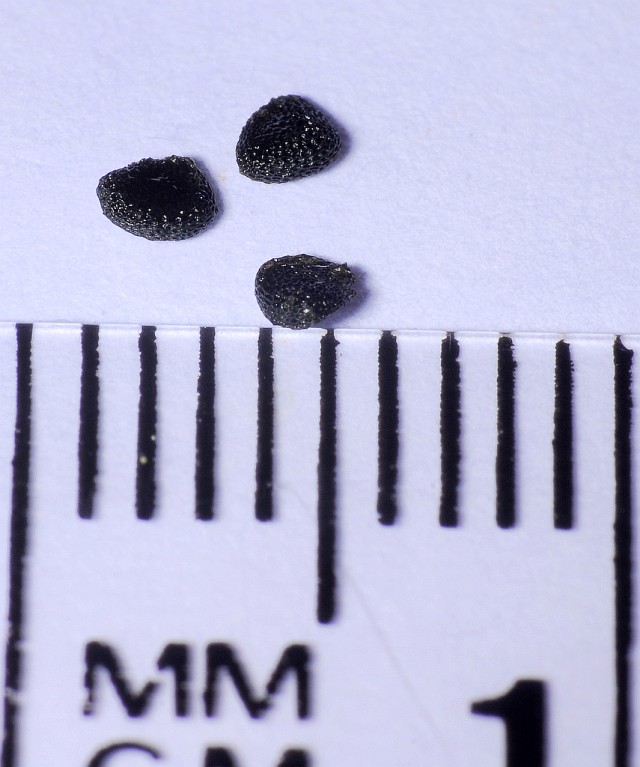
The flower of C. lanceolatum appears to be very much like many (if not most) of the 26-chromosome Brazilean Mata Atlantica area peppers: a white flower with purple streaks and green spots. The fruit looks a lot like C. eximium, but is without heat and has black seeds. The plant grows very slowly right after germination.
23. Capsicum mirabile (Mart.) |
 |
||
| Brazil (Minas Gerais, Rio de Janeiro, São Paulo) | |||
| Flower: °90 twisted | Corona: white | Spots: green with purple | |
| Calyx: teeth 5x2mm | Berry: yellow/green (green) | Heat: - | |
| Sweetness: - | Seed: Black/brown | Plant height: 3m | |
| Leaves: elliptical | Habit: | Chromosomes: 26 verified | |
|
Might be among the more common wild peppers in Brazil. Seeds are not available. |
|||
24. Capsicum pereirae (Barboza & Bianchetti) |
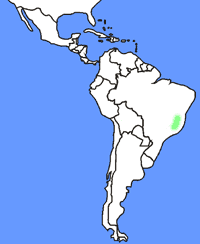 |
||
| Brazil (Espirito Santo, Minas Gerais) | |||
| Flower: stellar, pendant | Corona: white | Spots: green with purple | |
| Calyx: short or no teeth (5) | Berry: yellow/green (green) | Heat: present | |
| Sweetness: - | Seed: black/brown | Plant height: 0.8-2 (3)m | |
| Leaves: long, narrow, shiny | Habit: few branched | Chromosomes: 26 verified | |
|
Endemic to Brazilean states of Espirito Santo and Minas Gerais. The plant grows rare in shady, aquatic depressions and in highly fertile valleys between 1000..1600m altitude. Found only recently. The plant is related to C. flexuosum and C. schottianum. Seeds are not available. |
|||
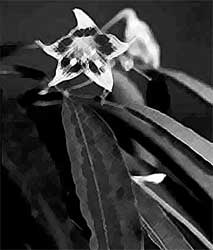 (c) Barboza & Bianchetti
(c) Barboza & Bianchetti
25. Capsicum recurvatum (Witasek) |
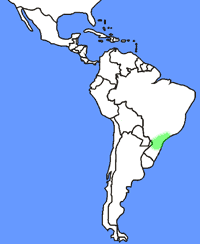 |
||
| Brazil (Paraná, Rio de Janeiro, Santa Catarina, São Paulo) | |||
| Flower: - | Corona: white | Spots: green, apparently small | |
| Calyx: 5-9 curved teeth | Berry: yellow, depressed (green) | Heat: - | |
| Sweetness: - | Seed: - | Plant height: 2.5-4m | |
| Leaves: - | Habit: tall | Chromosomes: - | |
|
A large plant, grows at least in Sierra de Bocaina national park west from Rio on 800..1500m altitudes. Appears to be a rather typical large "eastern capsicum" - the curved calyx teeth seem to make this species unique. Seeds are not available. |
|||
26. Capsicum rhomboideum (Kuntze) |
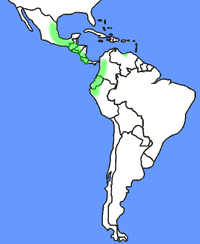 |
||
| From Southern Mexico to Northern Peru and Venezuela | |||
| Flower: rotate, lateral | Corona: yellow | Spots: no | |
| Calyx: 5 long teeth | Berry: red, depressed, 4-5mm | Heat: no | |
| Sweetness: slightly sweet | Seed: brown, very few | Plant height: 120..180cm indoors | |
| Leaves: pubescent, roundish shape | Habit: tall, few branches | Chromosomes: 26 verified | |
|
Known also as capsicum ciliatum (& witheringia ciliata), this is one of the most disputed species in capsicum. Due to its strange appearance, 13 chromosomes, yellow flowers and lack of pungency, rhomboideum has been thrown in and out of capsicum for decades, depending on what each particular researcher has believed to be fit. Most recent research by e.g. Hunziker, Barboza & Bianchetti has, however, finally placed this plant officially into genus capsicum. The plant is strange looking, to say the least. It doesn't resemble much any other chile plant - confusion has therefore been understandable. Rhomboideum is a relatively big plant with few, very long branches. Leaves growing from those branches are light green, clearly pubescent and unusually round in their shape. The medium-sized leaves stay unusually firmly attached to the plant (c.pubescens shares this trait). Flower is small, bell-shaped and bright yellow. Unusually long calyx teeth emphasize the small size of the clearly depressed, translucent berries which mature from green to white to red. There are only 1-2 seeds in the tiny berry. There is no pungency, but slight, pleasant sweetness is present in ripe fruits. Rhomboideum can be grown at home rather easily. It is highly pest tolerant and doesn't require strict conditions. Getting it to bloom and set fruit can, however, be a challenge, as in so many wild capsicums. Blooming nutrients might help. The plant isn't ugly, if not particularly pretty either, especially outside the blooming season. It takes a lot of space, although mostly upwards. Cold tolerance appears to be at least average. Seeds are not commercially available. Very rare in the chile growers' community. |
|||







See the light green, roundish, hairy leaves different from other capsicums we have seen so far. The flower is tiny, pretty, bright yellow.
27. Capsicum schottianum (Sendtner) |
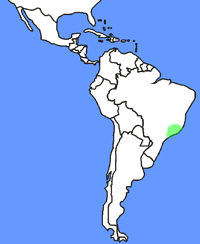 |
||
| Brazil (Minas Gerais, Rio de Janeiro, São Paulo) | |||
| Flower: 90° twisted | Corona: white | Spots: green/purple | |
| Calyx: no or short teeth (5) | Berry: transparent yellow (green) | Heat: present | |
| Sweetness: - | Seed: black/brown | Plant height: 1.5-4m | |
| Leaves: - | Habit: - | Chromosomes: 26 verified | |
|
A large plant. Formerly often believed to be the same as c.flexuosum. Grows in 500..1300m altitude in humid, bushy highlands. Appears to be a rather typical eastern capsicum. Related to c.flexuosum and c.pereirae. Seeds are not available. |
|||
28. Capsicum villosum (Sendtner) |
 |
||
| Brazil (Minas Gerais, Rio de Janeiro, São Paulo) | |||
| Flower: 90° twisted | Corona: white | Spots: purple-green (at base) | |
| Calyx: 5 x 2mm | Berry: yellowish-green (green) | Heat: present | |
| Sweetness: - | Seed: - | Plant height: 1-2m | |
| Leaves: pubescent | Habit: - | Chromosomes: 26 verified | |
|
Found in Brazil at least in Minas Gerais, Parana, Rio de Janeiro, Santa Catarina and Sao Paulo. Samples gathered from Boracéia Biologic Reservation in São Paulo and from Itatiaia National Park, Rio de Janeiro. Grows in 800..1300m altitude in bushy, sandy highlands. May live close to capsicum dusenii plants. Apparently two forms: capsicum villosum var. villosum and capsicum villosum var. muticum (Sendtner/Sendtner). Pubescent leaves of at least some sub-varieties seem to be unique for this species. Seeds are not available. |
|||
EPILOGUE:
Okay, some of you might question: "Hey, you guys are doing this in Finland, from all the places in the world..? Snow, sauna, endless forests, bears and swamps, Nokia phones, Kimi Räikkönen, monster-metal band Lordi winning the Eurovision song contest, and so on... How come do you care about tropical chili plants, or dare to claim that you know a thing about them?!"
Well... That would be a very good question. ;) Perhaps Lordi is the Answer. If Finland's first ever Eurovision win happened with a monster-dressed heavy metal band, would it be that strange if we grew tropical chili in one of the last places on Earth anyone would imagine...? You see, we are a little bit crazy here in Finland. If you have ever been to a genuine Finnish sauna, you know it's true. In fact, the Finnish Chile Association will try to cultivate a new pepper suitable for our harsh climate. Why? The answer is: why not? Chile - or capsicum (if we try to be a bit formal) - is not just about plants. It's an attitude. Therefore we, from the home of Santa Claws (ok, sorry: Santa Claus - I left my Lordi gear turned on...) invite you to Inferno, the forum and meeting place for people who like chili and other things with attitude and good spirit!
See you in our forums!




